Review: DALI Oberon 7C Wireless Speakers- No, we’re not talking about American take-away coffee here, but about Danish speakers . The Dali Oberon 7C wireless speakers not only look good – of course in all color versions – they also want to impress with their sound thanks to special solutions and bring their power amplifiers with them. The fact that the price remains reasonable makes the full-fledged floorstanding speakers really interesting.
With a recommended retail price of 2,097 euros for a pair of active speakers plus a matching wireless hub, the Danes play in a class that is as affordable as it is hotly contested. It doesn’t hurt that they don’t save on material, membrane surface or equipment and also set themselves apart from the competition in terms of technology. In view of the classic arrangement of the two woofers below the tweeter, for example, it is unusual that the Dali Oberon 7C are two-way and not two-and-a-half -way loudspeakers.
DALI Oberon 7C – The woofers
All drivers in Dali loudspeakers are developed in-house, including the Oberon 7C’s mid-bass drivers, which are equipped with cones made of a cellulose-wood fiber composite material and copper-coated aluminum voice-coil wire. Compared to copper, the light metal enables larger voice coil diameters and/or more windings for the same weight.
Dali is particularly proud of its SMC magnet system. SMC stands for “Soft Magnetic Compound” and aims to significantly reduce the effects of “distortion-generating mechanisms inherent in the usual architecture of chassis with voice coils”. For example, SMC minimize eddy current effects, increase flux linearity, reduce magnetic hysteresis (the residual magnetization remaining in ferromagnetic substances after an external magnetic field is switched off), and prevent excessive fluctuations in voice coil inductance at different positions in the magnetic field. How SMC works in detail is a well-kept secret, but Dali lets it be known that electrically non-conductive elements are introduced into the magnet structure and the effects mentioned are achieved in this way.
The tweeter
At 2450 hertz, a fairly large tweeter with a diameter of 29 millimeters with a textile dome takes over the sound radiation. Despite its large surface, its membrane is particularly light, which results in an unusual expansion in the super high frequency range for this size, according to Dali. The voice coil also has a diameter of 29 millimeters, which is good for efficiency, level stability and distortion behavior . In fact, I have often had positive experiences with such generously dimensioned tweeters in terms of sound purity. In this case, anyone who is concerned about the ultimate resolution should be reminded of the manageable price league.
Be that as it may, the price range of the Oberon 7C does not prevent Dali from filling ferrofluid in the voice coil gap of the tweeter, which significantly reduces the compression of the driver as the voice coil temperature rises – a natural consequence of high levels – and thus further the power handling should increase.
The case
The housings of the Dali Oberon 7C are made of MDF boards and are available in various wood laminate finishes or matt white lacquer. Internal rounded corners and cross braces are designed to optimize the rigidity of the cabinets and thus minimize parasitic panel resonances. In particular, the damping of the inwardly radiated midrange energy – without affecting the transient response of the drivers or the bandwidth in the bass range – is important to Dali. That’s why the damping materials were carefully selected and positioned and the bass reflex openings mounted on the back. In this way, less mid-range content should reach the listener than with an opening on the front.
According to Dali, the ports are designed to minimize exit airflow turbulence, as well as distortion and compression, while also considering the potential closeness of the rear panel. Despite the positioning of the fairly large reflex openings on the back, setting it up relatively close to a wall shouldn’t be a problem. The Dali Oberon 7C are equipped with rubber feet pre-assembled from the factory under the chic anthracite-colored foot frame – quite tiny spikes, but not suitable washers, are also included.
On the back of the Oberon 7C is an uncluttered connector panel with a power jack, a “Link Connect” button, and a diagram outlining five speaker locations. The USB-A socket is intended exclusively for service and does not accept any digital music signals. Hm, okay – no digital or analog physical inputs? Yes, that’s how it is, music flows exclusively via the radio link to the Dali Oberon 7C – more on that in a moment. The electronics module underneath integrates a radio element that communicates with the Dali sound hubs, the amplifiers including the power supply unit, the active crossover and a DSP.

double pack
The power amp section of a Dali Oberon 7C consists of two 50 watt power amps running in Class D mode . Wait a minute: two amps for three drivers? Correct, because as I said, it is a two-way system . Ergo, one of the amplifiers exclusively supplies the high-frequency driver and the second amp fires both woofers/midrange drivers. I can already hear you grumbling: is 50 watts enough for both bass reflex eighteen? Yes, I have to admit that my introduction to this text was not entirely correct. And to be honest, I had that thought too. Short.
Because if you think about it a little longer, it makes sense not to get into the marketing race for the highest wattage for loudspeakers in this class, but to orientate yourself towards the requirements of electrotechnical reality and to distribute the available budget sensibly: Firstly, the performance of the The power amplifier is connected directly to the voice coil of the chassis without detours via high-loss passive crossover components, and secondly Dali argues that the woofers of the Oberon 7C can be operated particularly efficiently and well-mannered thanks to the SMC technology. This fits in with the fact that a 65 VA power supply unit (also not exactly lavishly dimensioned on paper) intelligently manages the energy supply of both power amplifiers and, depending on requirements, quickly prioritizes one or the other. A solution,
sound hub
The wireless receiver of the Dali Oberon 7C obtains its signals over a 5.2 or 5.8 GHz radio link (the optimal band option is automatically selected depending on the local radio signal environment), using a 30-bit protocol . Both Sound Hubs from Dali are available as transmitters – for the Oberon C series, Dali recommends the compact version (299 euros), which I use in this test. Like its big brother (649 euros), the smaller hub is designed as the center for all connections. It wirelessly receives Bluetooth 5.0 signals in the AAC or aptX codec, for example from a smartphone, tablet or a Bluetooth-enabled smart TV or projector. A little anticipation of the practical test: It works wonderfully with my Philips PicoPix Max, a portable projector, and without any noticeable latencies.
In addition, the Dali Sound Hub Compact has two optical digital inputs and one HDMI input, but no coaxial S/PDIF and USB. The HDMI input is ARC-capable (Audio Return Channel) and supports CEC (Consumer Electronics Control), so it allows you to control the volume of the Dali Sound Hub Compact – and thus that of the Oberon C system – with the remote control of the connected television. Optical input number 2 is specially designed for connecting a TV. It has a light sensor and automatically switches the Sound Hub Compact to this input as soon as the television is switched on – before it even sends a sound signal. All other inputs have pure audio sensors that only switch when a signal is present.
Internally, the Sound Hub Compact works completely digitally, but of course you don’t want to deny access to analog signals from the record player or phono preamplifier or the tape decks, which are popular again in hipster circles. That’s why the Dali Sound Hub Compact immediately converts incoming analog signals into a 96 kHz/24-bit signal in order to forward it – like all other signals – to the DSP-based equalizer and crossover algorithms. Attentive readers may now be wondering what happened to the remaining six bits of the transmission log. They are needed “for feed-forward error correction, volume control, speaker identification and other functions,” according to Dali.
Above all, the larger Dali Sound Hub offers a more valuable appearance with a touch-sensitive glass plate as a cover, a digital coax input and an analogue RCA output as well as a volume control using a rotary knob on the front. In addition, in the larger model you have the option of integrating modules – for example for streaming via BluOS – into the slots provided on the back.
Subs welcome
Because the Oberon C series is designed for surround use as well as for stereo hi-fi and the Sound Hub Compact can manage up to five speakers wirelessly, the option of connecting an active subwoofer should not be missing – even if the Dali Oberon 7C with a lower limit frequency of 31 Hertz (-3 dB) is by no means a child of sadness as far as the draft is concerned. So the Sound Hub Compact offers a volume controlled analog RCA subwoofer output that turns on automatically when a connected device is detected.
Oberon optimized
Active frequency distribution and equalization of the music signal take place in the speaker itself, both on a 24-bit digital level. Equalization is the first step: At the very beginning, an equalizer “bends” the frequency response into a curve that is precisely tailored to the amplifiers, drivers and cabinet in order to create “an appropriate, neutral overall behavior in the listening room”, according to Dali. A measurement of the acoustics of the listening room does not take place here.
“Dynamic profiling” calculates the incoming signal based on the low-frequency component and the volume at which the loudspeakers play, and changes its dynamic characteristics in such a way that the drivers always work within their comfort zone and always with very low distortion values, says Dali. If we translate that casually, it is an intelligent compressor/limiter function. Dali attributes this technology in particular to the fact that it is responsible for a subjectively consistent sound pattern at all volume levels. After equalization, the crossover filter module divides the signal for the bass-midrange drivers and the tweeter through a low-pass filter and a high-pass filter.
Dali Oberon 7C: sound test and comparisons
The setup of the Dali Oberon 7C is exceptionally simple and convenient: it takes less than ten minutes from the first time the cutter is placed on the cardboard until music comes out of both speakers. Simply stand up and plug in the power cable, supply the Dali Sound Hub Compact with power, press the “Link Connect” buttons on the transmitter and receiver and select the left or right front position on the speakers – done. The smartphone can also be paired via Bluetooth intuitively and within around ten seconds.
Since it is not possible without a Sound Hub (Compact), all listening impressions and evaluations relate to the package consisting of the Oberon 7-C loudspeakers and the smaller of the two Dali radio centers. As Dali recommends, the speakers are placed with parallel side walls and a distance of 70 centimeters from the rear wall (Dali states 20 to 80 centimeters as an acceptable range).
Tonally effective
Powerful and dynamic with a dry, woody, but by no means pale tone impact – that’s how I would describe the bass character of the Dali Oberon 7C. The columns for the class play very well defined, differentiated and controlled with a crisp, springy impulse response in Massive Attack ‘s “Black Rain” from the album Heligoland . A slight energy boost in the upper bass may not be able to completely hide the tuning in my room, even with careful installation and a good 70 centimeters distance in the back, but there is neither wafting nor booming here or in the low bass – very good. Because the Dali Oberon 7 C climb pretty far down into the basement, stay relatively taut there and push a good amount of subsonic energy in the direction of the “popometer”.
A certain restraint in the fundamental tone and lower middle tone – which levels out somewhat with increasing break-in time – cannot be denied. The Oberon 7C don’t play as solidly sonorous in this area as, for example, the Canton Smart Vento 3 (2,300 euros). Unlike the bass range, voices like those of Jacintha or Nick Cave do not necessarily tend towards powerful fullness, but rather have a minimal tendency towards clean slenderness. Ron Carter ‘s plucked double bassseems to me a bit more sinewy and woody in the midrange than with most other speakers in this class – and better audible. The area from the upper midrange to the lower treble certainly also has a part in this impression, because the Dali Oberon 7C put a little shovel on it here. Subjectively, I perceive this tendency as a pleasant counterbalance to the powerful bass, and it also gives the sound a lively and lively character.
As a result, the treble of the Dali Oberon 7C can appear fresh overall: the crashing drums in the chaotic prelude to “Montagues and Capulets” on Romeo and Juliet in the performance of the Munich Symphony Orchestra under Sergiu Celibidachedeliver the Dali tweeter with grit and pepper, without drifting off into the unpleasant. This tweeter is skilfully tuned because it gradually fades into the super high tone and thus maintains an overall harmonious balance in the overtone complex. In addition, despite all its assertiveness, it is basically more fine and silky than crystalline or even metallic, which gives it a pleasant basic character. The tuning at low volumes deserves respect: Even at room volume, the deepest basses and fine dynamic nuances in the treble (the Dali Oberon 7C deliver well in this regard within the price range) are still clearly audible and comprehensible. So I put up with intelligent equalizing.
In view of the price range of these active wireless floor-standing loudspeakers, I consider the detailed resolution of what is happening across all frequency ranges to be just above average, despite their restraint in the super treble. With the exception of the very finest airiness and the most subtle vibrations of the drumsticks on Ron Carter’s live album Foursight – Stockholm Vol . Okay, some compact ones like the Elac Navis ARB-51 , which is also active and can be operated wirelessly(1,998 euros) delivers one or two more details in the treble. But the skilful over-all tuning of the Dali Oberon 7C, which is conducive to listening fun, lets audiophile criticism roll off anyway.
impulses, transients
As already indicated, the Dali Oberon 7C master most dynamic aspects with a high fun factor. Especially in the upper midrange and presence range, watching action films or listening to electronic music like Felix Labande’s “Black Shoes” from the Dark Days Exit album , even at high volumes, is incredibly fun . The Dali Oberon 7 C reproduce the transient-rich synth impulses as fast as an arrow, concisely and cleanly. The Dali Oberon 7C also master the coarse dynamics of voices or saxophones – Jacintha in “Moon River” or “Take Five” from the live album Jazz at the Pawnshop are examples here.
I then think I can hear the influence of “Dynamic Profiling” at very high volumes in the bass range: when the heat of the home cinema battle or a The Prodigy live performance involves the most violent bass attacks, the bass drivers of the Dali Oberon 7C hold themselves in favor of a clean one and distortion-free playback a little back. In the end, a 50 watt power amplifier is not heavy artillery – not even with active loudspeakers . But if the available power is used as intelligently and sound-promotingly as it is here, it doesn’t matter. No, I even welcome it. Because who really rolls of thunder, Godzilla or Liam HowlettsIf you want to bring breakbeats into your 25 square meter room, you should invest in a good subwoofer and stress-resistant neighbors anyway.
Space and illustration
The next cabinet piece follows immediately: the DALI Oberon 7C design an impressively large, almost powerful room. However, the imaging does not take place in front of the loudspeakers, as one might assume given the lightning-fast transients and crashing impulses. If the recording allows it, the Dali open up the space – starting at the baseline – rather far back. In addition, the Oberon 7 C stagger the individual gradations in the depth dimension surprisingly clearly and cleanly. In particular, when playing back films, the speakers convincingly fade out of the stage and open up a free, airy space – even the coax-equipped Elac Navis ARB-51 can’t do that any better.
Only in very chaotic and loud passages with a full orchestra, such as in the aforementioned “Montagues and Capulets”, do the loudspeakers lose a little overview of the imaging. The concise presence area seems to be noticeable here. From a certain volume, if something very complex is happening acoustically in the middle/treble, it can become a bit dominant and allow information important for spatial localization to recede into the background. The advantage of this tonal tuning at normal volumes is a very sharply defined and, for this price range, almost outrageously three-dimensional reproduction of voices and instruments, which sets standards in this league. The creaking saxophone on Jazz at the Pawnshop ‘s “Take Five.”and Chilly Gonzalez Piano on Room 29 have a tangible quality that I certainly would not have expected from active loudspeakers in the price range around 2,000 euros.
Conclusion: DALI Oberon 7C
With their agile and powerful gait, the Dali Oberon 7 C are particularly suitable for electronic music and powerful rock and blues. Anyone who likes spaciousness and tangible images will also enjoy the Danes. In any case, Dali’s not exactly puristic-traditional approach to intelligent sound processing delivers remarkable results.
In the class around 2,000 euros, the Dali Oberon 7C is therefore a very attractive offer. In addition, they are extremely easy to set up and use, stood out in the test due to the absence of problems – and can be used in rooms from 20 to around 40 square meters.
DALI Oberon 7C …
- have an astounding impulse and transient reproduction in the middle and high frequencies for the price range.
- show a positively effective, targeted tonal tuning, which in combination with the dynamic gait is a lot of fun.
- play in the bass dry, powerful, deep, amazingly controlled and differentiated with a slight emphasis on the upper bass.
- realize a clear, clean middle region with a slightly slimmer vocal reproduction with a slightly reduced fundamental and lower middle tone.
- subjectively balance the powerful bass with a slight emphasis on the presence region.
- fade out the super treble gently with increasing frequency.
- build up a large, almost mighty space and thereby focus more on breadth and depth than on the listener. The localization is precise and handy.
- are a bit reserved in terms of coarse dynamics at very high volumes.
- play completely tonally and dynamically even at low listening volumes.
- have above-average resolution in almost all frequency ranges. Some (more expensive) competitors offer a little more air, shine and information in the treble.
- are well made for their price class and extremely easy to put into operation.
- can only be controlled wirelessly with a Dali Sound Hub (Compact), an uncomplicated, user-friendly device – also for home cinema applications.
DALI Oberon 7C Facts:
Model: Dali Oberon 7C
- Concept: active two-way floorstanding speaker with bass reflex system
- Price: 1,798 euros (pair)
- Dimensions & Weight: 101.5 × 20 × 34 cm (HxWxD), 14.8 kg/each
- Power: 2 x 50 watts sinus per speaker
- Versions: varnish white, light oak veneer, dark walnut and black ash
- Inputs: Dali radio module
- Miscellaneous: Connection only with Dali Sound Hub (Compact)
- Guarantee: 5 years
Model: Dali Sound Hub Compact
- Concept: proprietary wireless preamp
- Price: 299 euros
- Inputs: 2 × optical (Toslink), 1 × HDMI (ARC), 1 × analog high level (RCA), Bluetooth 5.0 (AAC, aptX, aptX HD), 1 × USB-A for service
- Outputs: 1 × subwoofer out (RCA), RF wireless 5150-5250 MHz / 5725-5875 MHz for connecting the speakers with up to 24-bit/96 kHz
- Dimensions and weight: 30 × 212 × 132 mm (H×W×D), 0.5 kg
- Power supply: 9V (DC)
- Power consumption (standby/max.): 1.7 watts / 2.8 watts
- Other: IR remote control


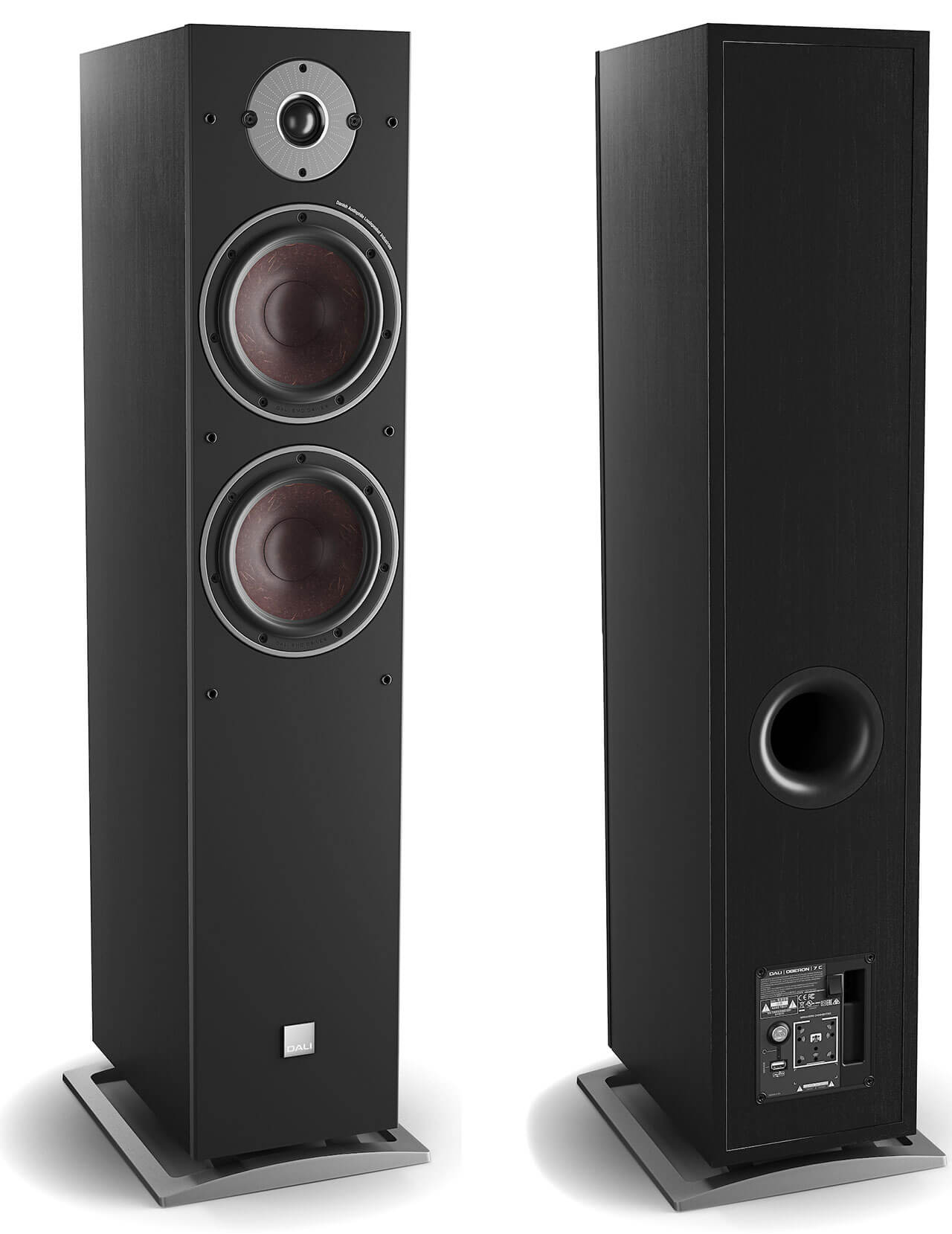

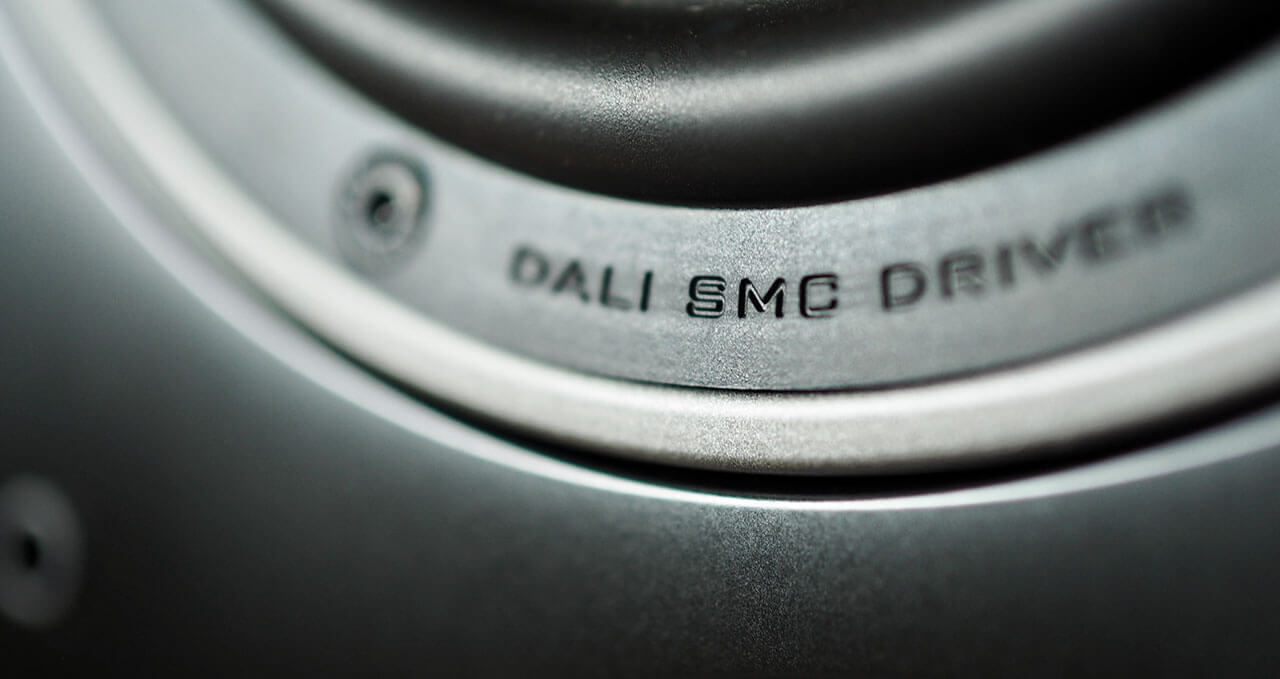

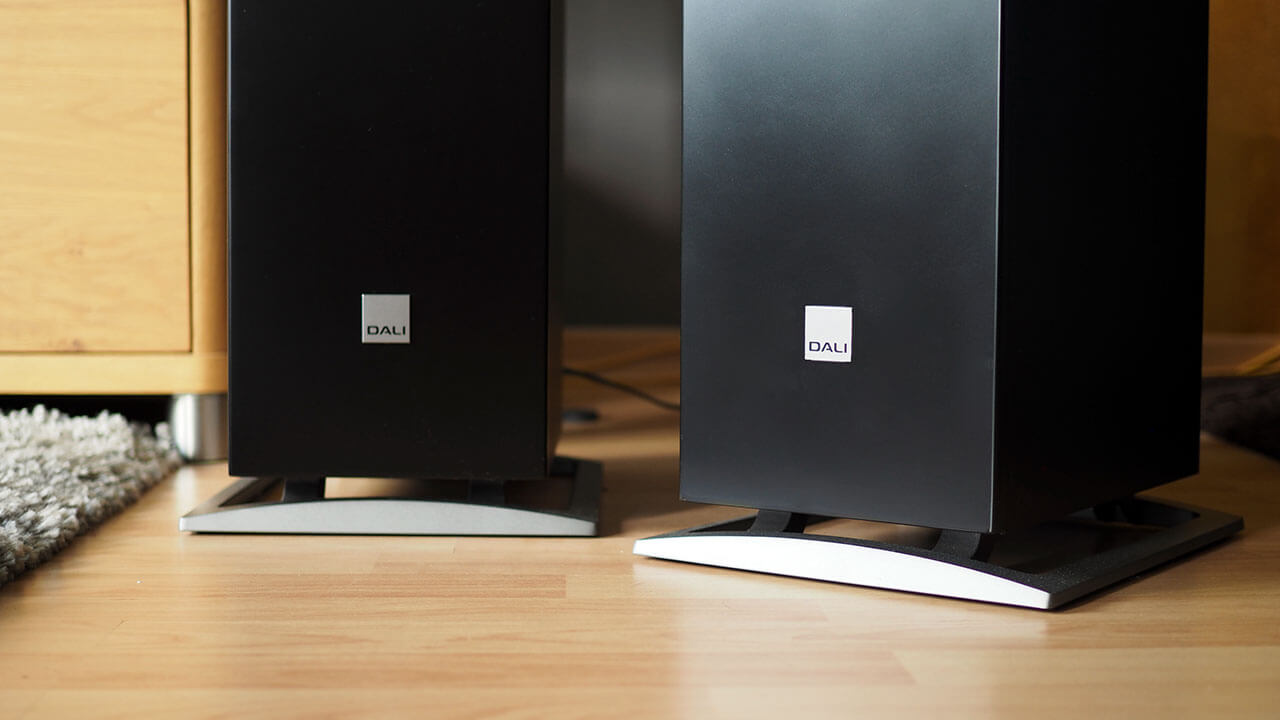
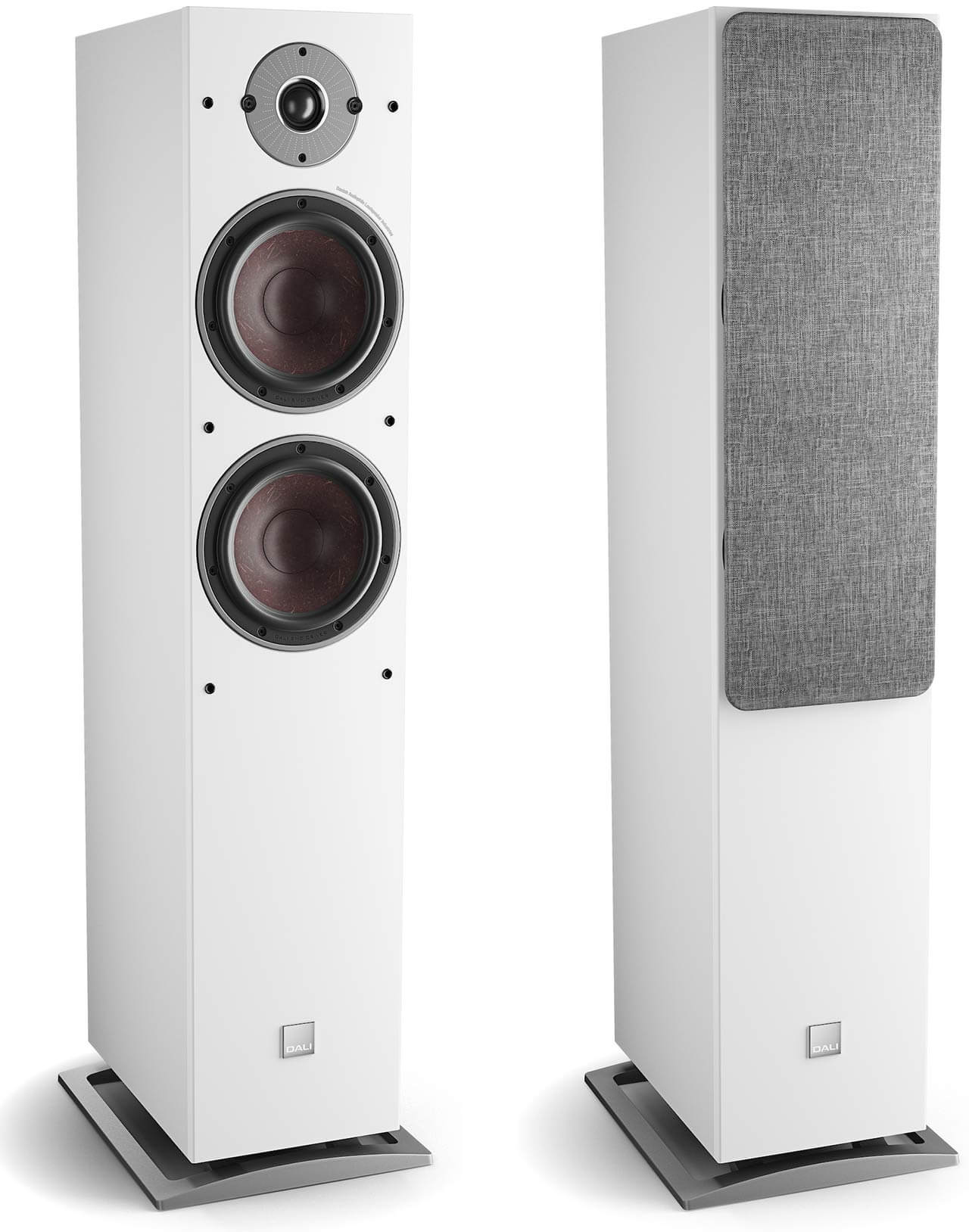





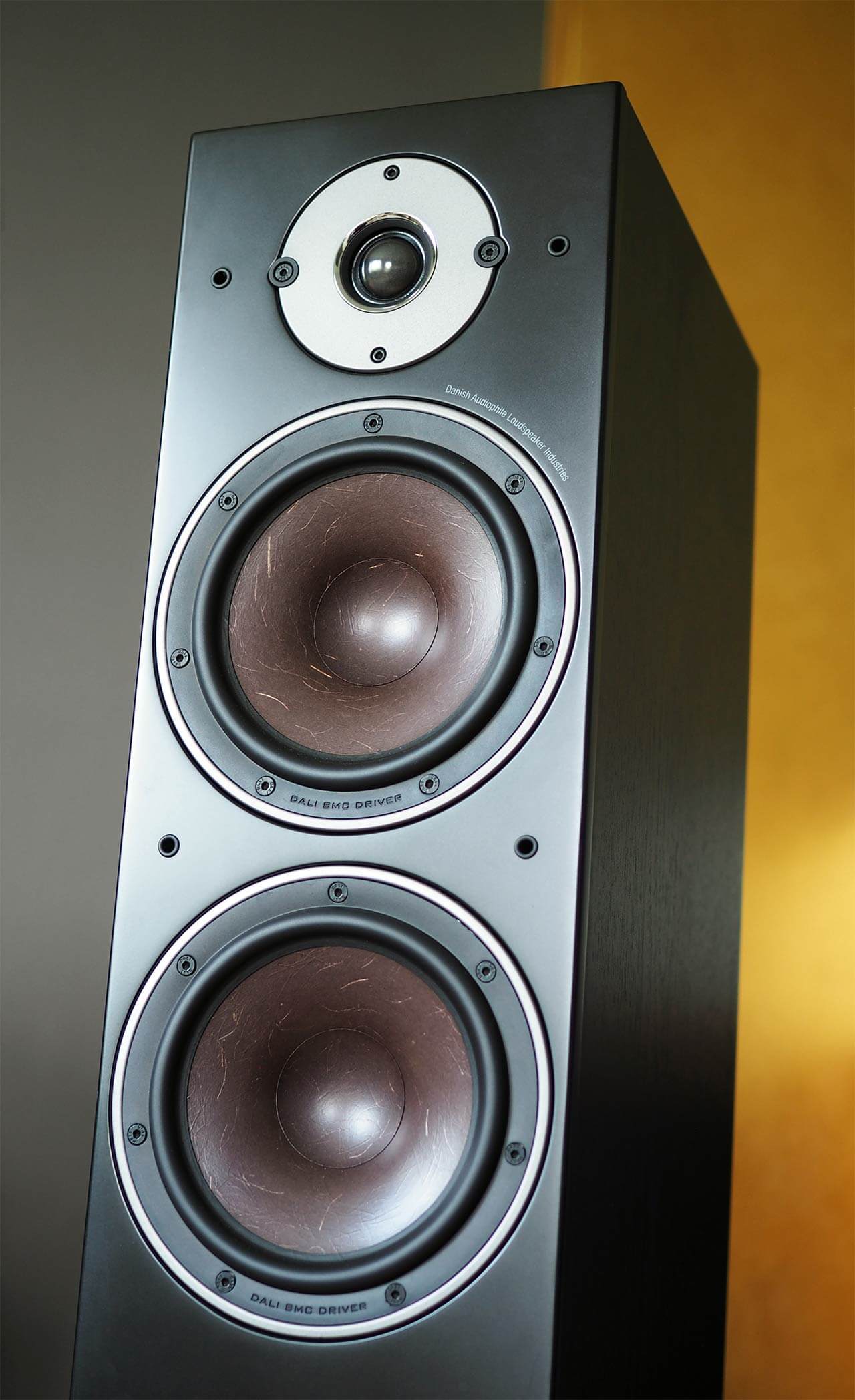
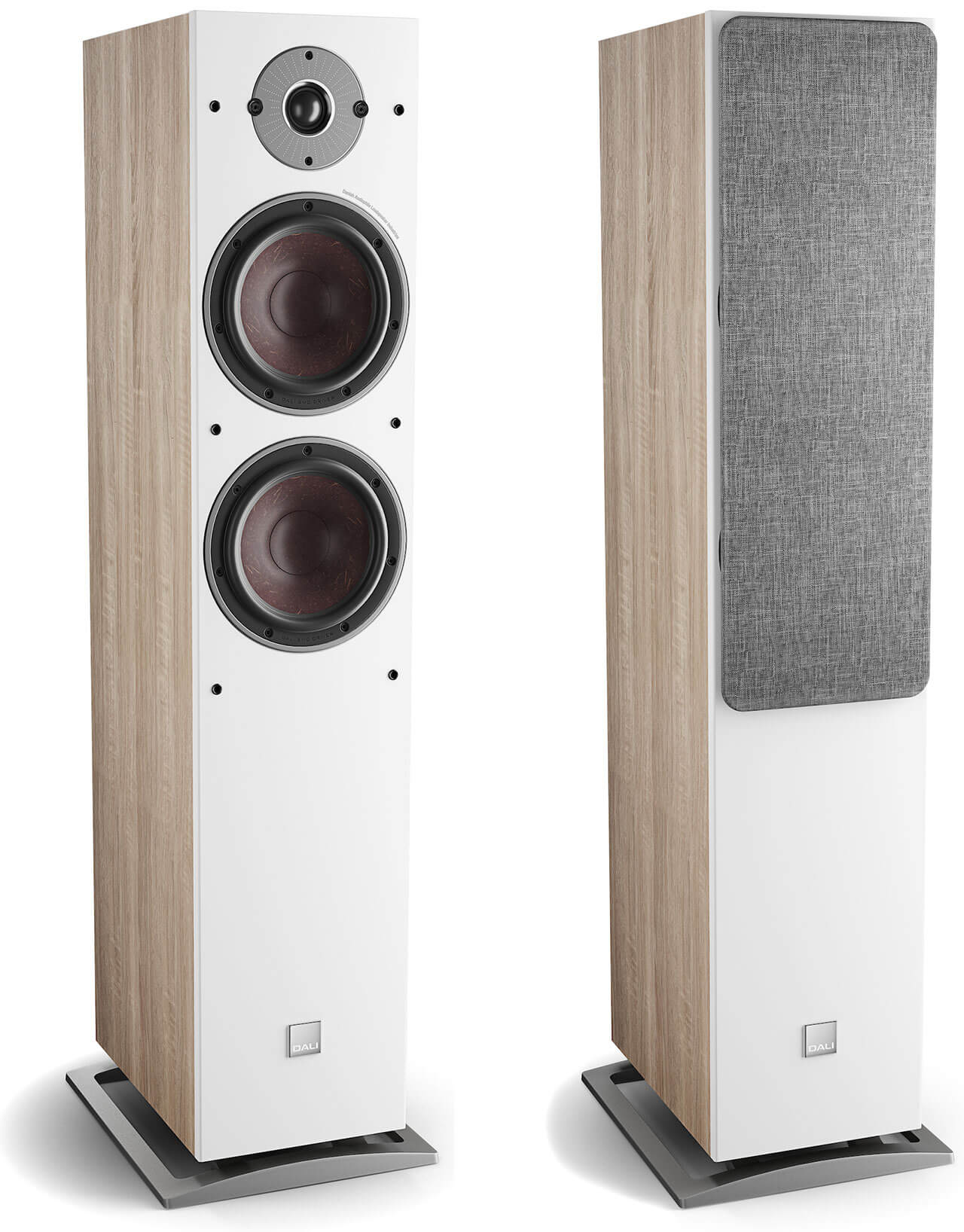


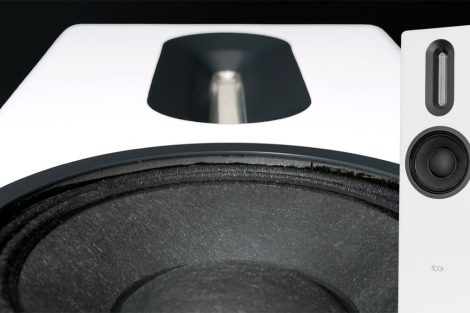
Add Comment